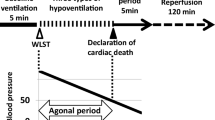Abstract
Objective: This study was undertaken to clarify what damage to a lung during cold storage influenced the function of transplanted lung after reperfusion.Methods: We examined the ultrastructural damage in preserved right lung before reperfusion, and the function of transplanted left lung, in a same dog and measured the pulmonary artery oxygen pressure after reperfusion and the wet-to-dry-weight ratio. We compared these findings between those dogs that survived until six hours after reperfusion (Alive Group) and those dogs that did not survive (Dead Group). We also investigated any correlation between the ultrastructural damage in the preserved lung and the function of the transplanted lung.Results: The frequency of protrusion and destruction of the endothelial cells in the small pulmonary artery, and vacuolization of pneumocytes, in the Dead Group was significantly higher than that in the Alive Group. A correlation was found between the frequency of two kinds of ultrastructural damage; vacuolization in the endothelial cells in the small pulmonary artery and vacuolization in the pneumocytes, and the pulmonary artery oxygen pressure at 1-hour after reperfusion. A correlation was also found between the frequency of the vacuolization of pneum ocytes and the wet-to-dry-weight ratio.Conclusions: Findings suggested that a lung suffering severe damage to intracellular structure during hypothermic preservation is unable to function sufficiently after reperfusion and is at high risk for early graft failure.
Similar content being viewed by others
References
Kawahara K, Itoyanagi N, Takahashi T, Akamide S, Kobayashi M, Tomita M. Transplantation of canine lung allografts preserved in UW solution for 24-hours. Transplantation 1993; 55: 15–8.
Lin PJ, Hsieh MJ, Cheng KS, Kuo TT, Chang CH University of Wisconsin solution extends lung preservation after prostaglandin E1 infusion. Chest 1994; 105: 255–61.
Oka T, Puskas JD, Mayer E, Cardoso PFG, Shi S, Wisser W, et al. Low-potassium UW solution for lung preservation. Transplantation 1991; 52: 984–8.
Miyoshi S, Shimokawa S, Schreinemakers H, Date H, Weder W, Harper B, et al. Comparison of the University of Wisconsin solution and other crystalloid perfusates in a 30-hour rabbit lung preservation model. J Thorac Cardiovase Surg 1992, 103: 27–32.
Date H, Matsumura A, Manchester JK, Obo H, Lima O, Cooper JM, et al. Evaluation of lung metabolism during successful twenty four-hour canine lung presetvation. J Thorac Cardiovasc Surg 1993, 105 180–91.
Bando T, Kosaka S, Liu CJ, Hirai T, Hirata T, Yokomise H, et al. Effects of newly developed solutions containing trehalose on 20-hour canine lung preservation. J Thorac Cardiovasc Surg 1994, 108, 92–8.
Wada H, Liu CJ, Hirata T, Bando T, Kosaka S. Effective 30-hour preservation of canine lungs with modified ET-Kyoto solution. Ann Thorac Surg 1996, 61: 1099–105.
Liu CJ, Ueda M, Kosaka S, Hirata T, Yokomise H, Inui K, et al. A newly developed solution enhances thirty-hour preservation in a canine lung transplantation model. J Thorac Cardiovasc Surg 1996, 112: 569–76.
Kosaka S, Bando T, Liu CJ, Suzuki Y, Hitomi S, Wada H. Ultrastructural changes in canine lung preserved in newly developed solutions. J Surg Res 1996; 63: 467–73.
Keshavjee SH, Yamazaki F, Yokomise H, Cardoso DF, Mullen JB, Slutsky AS, et al. The role of dextran 40 and potassium in extended hypothermic lung preservation for transplantation. J Thorac Cardiovascular Surg 1992; 103: 314–25.
Veith FJ, Richards K. Improved technique for canine lung transplantation. Ann Surg 1970, 171; 553–8.
Yokomise H, Wada H, Inui K, Yamazaki F, Lee M. Aoki M, et al. Application of laser doppler velocimetry to lung transplantation. Transplantation 1989; 48: 550–4.
Cooper JD, Current status of lung transplantation. Transplant Proc 1991;21: 2107.
Lemasters JJ, Stemkowski CJ, Sungchul JI, Thurman RG Cell surface changes and enzyme release during hypoxia and reoxygenation in the isolated, perfused rat liver. J of Cell Biology 1983, 97: 1778–86.
Downing TP, Sadeghi AM, Baumgartner WA, Reitz BA, Brackup A, Freeley T, et al. Acute physiological changes following heart-lung allotransplantation in dogs. Ann Thorac Surg 1984; 37: 479–83
Hachida M, Morton DL. Lung function after prolonged lung preservation. J Thorac Cardiovase Surg 1989, 97; 911–9.
Paull DE, Keagy BA, Kron EJ, Wilcox BR. Reperfusion injury in the lung preserved for 24 hours. Ann Thorac Surg 1989; 47, 187–92.
Detterbeck FC, Keagy BA, Paull DE, Wilcox BR Oxygen free radical scavengers decrease reperfusion injury in lung transplantation. Ann Thorac Surg 1990; 50: 204–10.
Barrowcliffe MP, Jones JG. Solute permeability of the alveolar capillary barrier. Thorax 1987; 42: 1–10.
Fahrenbach H, Hirt SW, Wahlers T, Schnabel PA, Harverich A, Richter J. Euro-Collins flush perfusion in human lung preservation-ultrastructural studies of the preservation quality of the contralateral donor lung in clinical lung transplantation. J Heat Lung Transplant 1994; 13: 1–14.
Lehtola A, Harjula A, Heikkila L, Hämmämen P, Taskinen E, Kurki T, et al. Single-lung allotransplantation in pigs following donor pretreatment with intravenous prostaglandin E-1. Scand J Thorac Cardiovasc Surg 1989; 23: 193–9.
Author information
Authors and Affiliations
Rights and permissions
About this article
Cite this article
Kosaka, S., Ueda, M., Bando, T. et al. Ultrastructural damage to the preserved lung and its function after reperfusion. Jpn J Thorac Cardiovasc Surg 50, 6–14 (2002). https://doi.org/10.1007/BF02913480
Received:
Accepted:
Published:
Issue Date:
DOI: https://doi.org/10.1007/BF02913480




